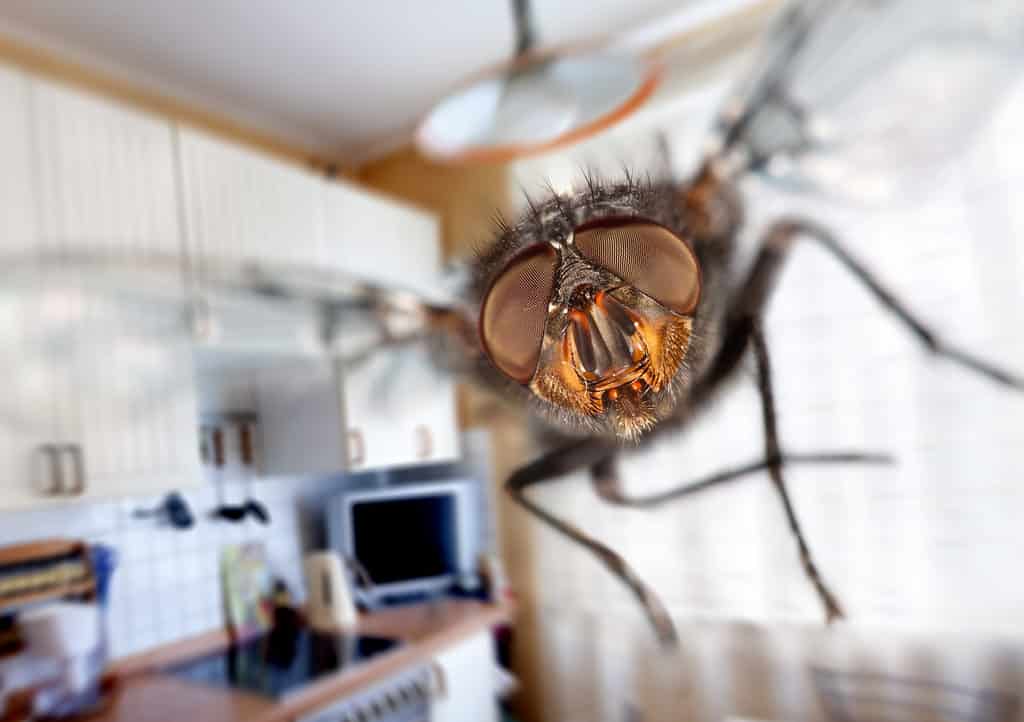The most common type of fly found in and around homes, the house fly has an uncanny ability to avoid the fly swatter. But it might be their stellar acrobatics rather than their speed that keeps them buzzing for another day. House flies average about five miles per hour, about the same as a brisk walk.
Why Are House Flies So Much Faster Than Humans?
House flies have a secret weapon to help them avoid predators and others who just plain don’t like them. Two dumbbell-shaped limbs that emerge from below their hind wings to stabilize their takeoff and flight allow the insects to launch into the air effortlessly and make razor-sharp turns during flight.
Why Is It So Hard to Swat a House Fly?

To a fly, humans are moving in slow motion as we try to swat them, making them difficult to catch.
©Devenorr/iStock via Getty Images
The reason house flies often outmaneuver swats from humans has more to do with the speed at which they see the world rather than the speed at which they fly. To a house fly, we are literally moving in slow motion. Turns out the general rule is the smaller the creature, the quicker the vision. Humans see about 60 flashes per second — the way scientists measure the speed a species sees — and flies see about 250 flashes per second.
How Do Flies Make That Buzzing Sound?
House flies make that buzzing sound when they are beating their two wings in flight. Many flying insects make a buzzing noise as they fly. Depending on the species, the sound will be a low or high buzz.
How Long Do Flies Live?
Contrary to popular belief, flies do not have only one day to annoy you. The adult house fly has a normal lifespan of about 30 days during warm weather but can live up to five months.
What Disease Do Flies Spread?
House flies are infamous for not being picky eaters. They don’t discriminate between your freshly cut watermelon and a pile of dog feces. They are just as happy attending your family picnic as indulging in a feast of rotting garbage at the dump. These eating habits make them the perfect host for more than 100 different pathogens when they land on infected feces and then land on your sandwich. They also defecate constantly, which spreads even more bacteria. House flies are proven carriers of germs such as gangrene, Typhoid, bubonic plague, listeria, leprosy, tuberculosis, and many more.
Where Do House Flies Originate From?

House flies seem to show up out of nowhere in our homes. Although they originated in the Middle East, they now thrive in all inhabited areas of the globe.
©iStock.com/cookelma
The common house fly originated on the steppes of central Asia, particularly the Middle East. The species now thrives on all inhabited continents in all climates from tropical to temperate in all different kinds of environments. House flies likely owe their worldwide dispersal to our own success as they seem to enjoy our company and our trash.
Do House Flies Bite?
A house fly doesn’t have any teeth, so it can’t bite. It can only feed on liquids. They use their sponging mouthparts to liquefy solid foods through spitting or regurgitation. House flies use their tongues like straws to suck up the liquefied food.
What Is the Fastest Insect?
Surprisingly, little research has been done to measure the speed of flying insects as it can be difficult to get an accurate speed. The University of Nebraska-Lincoln reports, however, that the common horse fly can achieve speeds estimated at 90 miles per hour! We should be grateful these large flies — they can reach two-thirds of an inch long — aren’t as interested as the house fly in joining us in our homes. Unfortunately, horses aren’t so lucky. Like male mosquitoes, male horse flies prefer plant nectar, but like female mosquitoes, the female horse fly makes a meal out of blood. These flies can and do bite before feasting on blood.
How to Measure the Speed of an Insect

Dragonflies are among the fastest flying insects. One claim reported a
dragonfly
reaching 97 miles per hour, although others dispute the claim.
©Karyn Honor/Shutterstock.com
Many factors must be taken into account, making getting an accurate account of an insect’s speed a tricky endeavor. This may be why little verified research has been done into the flight speed of various insects. The University of Florida’s entomology department reports, “The speed attainable by insects is currently poorly understood” and “that insect airspeed is one of the least known features of flight performance.”
Some of the factors scientists have used to determine flight speed are:
- Insect age
- Insect gender
- Wind speed
- Ascent angle
- What fuel the insect has before flight
- Mass of the insect
- Size of the insect
- Age of the insect
- Temperature and humidity level
- Whether the insect is free-flying
- Whether the insect is wild or lab-raised
Discover the Flying Speed of a House Fly Compared to Other Insects
| Rank | Species of Flying Insect | Top Flying Speed in miles per hour (mph) |
|---|---|---|
| Too slow to rank | House fly | 5 mph |
| 1. | Horse fly | 90 mph |
| 2. | Dragonfly | 60 mph |
| 3. | American deer bot fly | 50 mph |
| 4. | Honeybee | 40 mph |
| 5. | Skipper butterfly | 37 mph |
| 6. | Ladybug | 37 mph |
| 7. | Hawk moth | 33.7 mph |
| 8. | Bumblebee | 28 mph |
| 9. | Asian Giant Hornet | 25 mph |
| 10. | Locust | 20 mph |
The photo featured at the top of this post is © Abel Tumik/Shutterstock.com
Thank you for reading! Have some feedback for us? Contact the AZ Animals editorial team.






